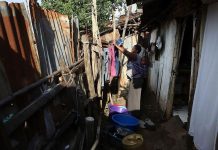The smell of Wakulima Market hits you before you actually see it. It announces itself with a stench that assaults your nostrils as you set foot in Nairobi’s most important fresh produce market.
Once you are in the market, the stench is almost unbearable.The unacquainted buyers twitch their noses as they walk past the selection of food items – plantains, watermelons, passion fruits, cabbages – but the traders are not bothered. It is a smell they are accustomed to.
At Wakulima and the neighbouring Muthurwa, rotting mountains of garbage compete for space with heaps of cabbages and green maize. Raw sewage competes for way with buyers, then finally flows on its merry way to join vehicular and human traffic on Haile Selassie Avenue.
Uncollected for days, another mountain of garbage is forming opposite the market’s entrance, at the base of the metal barrier on the median of the avenue.The traders with spots under the canopy are better off. Those in the open, especially those dealing in vegetables such as kales, are exposed to the vagaries of weather.In her spot just in front of an area where handcarts are parked, a woman lays out her wares – vegetables, keen to avoid a smelly puddle of black mud that has formed in front of her.
In its state, Wakulima is the best of the lot. Muthurwa is a cesspit. It was only towards the end of December and after protests that the county administration collected garbage that had accumulated for three months.At the section of Muthurwa Market near the bus stage bordering Wakulima, buyers jump over the dark and murky sewage and handcarts splash some of it on the produce. A lone cabbage that rolls away from the heap into the stinky mud is hastily retrieved, cleaned and put back at its spot.
The situation at Muthurwa is a stark contrast to the promise that the Sh700 million unit held when it was launched by President Mwai Kibaki in 2007.The market was a failure at launch. Traders are selling food in the squalid conditions that the market was expected to cure. Food stalls are in front of garbage heaps.Despite the county government collecting Sh180 million from Wakulima Market in 2016/17 financial year, and Sh35 million from Muthurwa, the two markets are in a deplorable state.
Better state
“Right now we are in a better state because there is some consistency in the garbage collection. Last December was very difficult and we had to complain to Jaguar (Starehe MP Charles Njagua) to have the garbage cleared. The most it could go without collection is a week,” says Lucy Wangui, a trader in the market for 20 years.
Other markets in the city such as Gikomba and Kangemi are not any better. Congestion. Lack of water. Mountains of garbage. Burst and open sewers. Traders, lacking functioning toilets, urinate in the open.Yet the county made Sh378 million from its markets, according to the 2019 Annual Development Plan report, which provides figures from the 2016/17 financial year.
What is the county doing with the millions it collects from these markets? Wakulima, popularly known as Marikiti, is bursting at the seams. Or at the sewers.Unable to find space in the market, a number of traders are now creeping onto the sidewalk on Haile Selassie Avenue. The county says the market is meant to host as many as 2,000 traders. The market was opened in 1967, and has never been expanded to match the growing number of traders. The open sewers are a manifestation that the market cannot handle the pressure of a city whose population is creeping towards five million.
The result is a jostle for the limited market slots that have led to a number of traders opting to sell from handcarts, and along the highway.To move inside the market, you need to be flexible, agile even – it requires skill in order not to collide with the porters and or to step on commodities laid out for buyers.
Loise Wambui, who deals in green peas and has traded in the market since 2003, says the traders are often jostling for space.“You can come and find that someone else is selling from your space and you have to move someplace else where there are no customers.“And when you move to some other place you will be ejected,” she said, pointing to a platform beyond the open parking area where porters are unloading sacks from lorries.
“When I came here in 2003, there wasn’t even half as many people as there are now.”Cyrus Kaguta, chairman of Wakulima Traders Association, says the market is congested. It was built to accommodate 300 traders but the number is tenfold.“Those are just the traders. We have 6,500 registered members of the market – transporters, traders and porters. And not everyone is registered. The number could be as high as 10,000 people in Wakulima market,” he says.
At peak hours, especially in the evenings, one lane of the highway is closed off by the traders. From the footbridge to the hawker’s section in Muthurwa to the Kenya Farmers Association building, traders fill the streets and pedestrians and vehicles have to skirt around them.
There have been attempts to relocate the traders to another market in Kangundo Road constructed by the Kenya Urban Roads Authority (Kura) in 2018 as an alternative location so Wakulima can give way to an overpass from Enterprise Road.The Sh800 million new Wakulima Market is being built on a 45-acre piece of land through funding from the Japan International Cooperation Agency (JICA).
That move has not gone down well with the traders at Marikiti, many of whom seeing it as a loss of vital opportunity and income.That market is meant for traders in Eastlands, Lucy Wangui says.“We have been having discussion with Kura and JICA for the past two years and it was agreed that we will not move if we have nowhere else to go,” Wangui says.At the county government’s office in the market, a plan for a new market has been pinned by the traders’ association as an assurance to the traders that there are no plans to move them.The map illustrates the current market, and a proposed expansion on the adjacent vacant railway land.
Green colours
Currently, there are three other markets under construction – Mwariro in Kariokor, already painted the yellow and green colours of the county government as the project progresses; Westlands Market and a five-storey one in Gikomba that is being built by the national government.In Kariokor, the county government is putting the final touches on Mwariro Market, a three-storey 356-stall market that will host the growing number of hawkers in the city.These new markets will probably ease the congestion, or offer better conditions for traders and their customers.But at the moment, as workers on site are painting and fitting electrical components, city dwellers out to get their supplies will just have to continue jumping over stinking raw sewage, rotting mounds of garbage and heaps of fresh vegetables, while twitching their noses.






